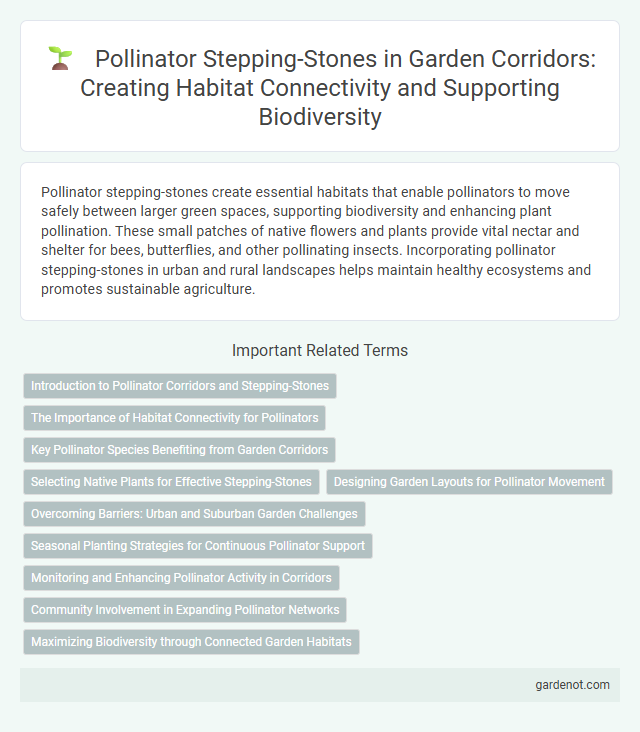Pollinator stepping-stones create essential habitats that enable pollinators to move safely between larger green spaces, supporting biodiversity and enhancing plant pollination. These small patches of native flowers and plants provide vital nectar and shelter for bees, butterflies, and other pollinating insects. Incorporating pollinator stepping-stones in urban and rural landscapes helps maintain healthy ecosystems and promotes sustainable agriculture.
Introduction to Pollinator Corridors and Stepping-Stones
Pollinator stepping-stones serve as crucial habitat patches that enhance connectivity within pollinator corridors, facilitating the movement and foraging of bees, butterflies, and other pollinating species. These small, strategically placed floral resources support biodiversity by providing rest stops and food sources in otherwise fragmented landscapes. Integrating stepping-stones into pollinator corridors improves ecosystem resilience and promotes pollination services essential for agricultural productivity and wild plant reproduction.
The Importance of Habitat Connectivity for Pollinators
Pollinator stepping-stones serve as crucial habitat patches that enhance landscape connectivity, enabling bees, butterflies, and other pollinators to traverse fragmented environments and access vital resources. These small, strategically placed areas of native flowering plants increase foraging efficiency and genetic exchange between isolated populations. Maintaining interconnected habitats supports pollinator health, biodiversity, and ecosystem resilience essential for crop pollination and natural plant reproduction.
Key Pollinator Species Benefiting from Garden Corridors
Pollinator stepping-stones provide critical habitats for key pollinator species such as bumblebees, monarch butterflies, and native solitary bees, enhancing their foraging and breeding success. These garden corridors support genetic diversity and population connectivity by linking fragmented natural landscapes. Native flowering plants within these stepping-stones offer essential nectar and pollen resources vital for sustaining pollinator health and ecosystem stability.
Selecting Native Plants for Effective Stepping-Stones
Selecting native plants for pollinator stepping-stones enhances habitat connectivity by providing essential nectar and pollen resources tailored to local pollinator species. Prioritize flowering plants with staggered bloom times to ensure continuous food supply throughout the growing season, supporting diverse pollinator populations. Incorporating a variety of native grasses, wildflowers, and shrubs creates microhabitats that facilitate pollinator movement and reproduction along the corridor.
Designing Garden Layouts for Pollinator Movement
Pollinator stepping-stones are strategically placed patches of native flowering plants that facilitate movement between larger habitat areas, enhancing connectivity for bees, butterflies, and other pollinators. Designing garden layouts with diverse, seasonally blooming plants arranged in clustered groups maximizes resource availability and supports continuous pollinator foraging pathways. Incorporating varied plant heights and sheltering structures within corridors improves habitat quality and encourages safe movement across fragmented urban or agricultural landscapes.
Overcoming Barriers: Urban and Suburban Garden Challenges
Pollinator stepping-stones mitigate habitat fragmentation by providing essential floral resources and nesting sites in urban and suburban gardens. These green patches counteract barriers such as paved surfaces, limited native plant diversity, and pesticide exposure, creating corridors that enable pollinator movement and gene flow. Integrating diverse, native flowering plants in residential landscapes supports pollinator health and enhances urban biodiversity connectivity.
Seasonal Planting Strategies for Continuous Pollinator Support
Pollinator stepping-stone gardens employ carefully planned seasonal planting strategies to ensure continuous blooms that provide essential nectar and pollen resources throughout the year. Incorporating early spring bulbs, summer perennials, and late-flowering annuals creates a seamless sequence of food sources for pollinators like bees, butterflies, and hummingbirds. These strategies enhance habitat connectivity and promote sustained pollinator health within urban and rural landscapes.
Monitoring and Enhancing Pollinator Activity in Corridors
Pollinator stepping-stones serve as critical habitats within corridors, supporting the movement and foraging of diverse pollinator species. Monitoring techniques such as remote sensing and automated insect traps provide precise data on pollinator abundance and activity patterns. Enhancing pollinator activity involves planting native flowering species rich in nectar and pollen, and minimizing pesticide use to improve habitat quality and connectivity.
Community Involvement in Expanding Pollinator Networks
Pollinator stepping-stones serve as crucial habitats that connect fragmented landscapes, enabling pollinators like bees, butterflies, and hummingbirds to safely traverse and forage. Community involvement plays a vital role in expanding these networks by encouraging local planting initiatives, educational programs, and citizen science projects that enhance habitat connectivity. Engaging residents in creating native flowering gardens and maintaining green corridors significantly boosts pollinator diversity and resilience in urban and rural areas.
Maximizing Biodiversity through Connected Garden Habitats
Pollinator stepping-stones are strategic garden habitats designed to connect fragmented ecosystems, enabling safe passage and resource access for pollinators such as bees, butterflies, and hummingbirds. These connected green spaces maximize biodiversity by supporting diverse plant species that provide continuous nectar and pollen sources throughout the growing season. Enhancing habitat connectivity boosts pollinator populations, which in turn improves pollination efficiency and ecosystem resilience.
Pollinator stepping-stone Infographic

 gardenot.com
gardenot.com